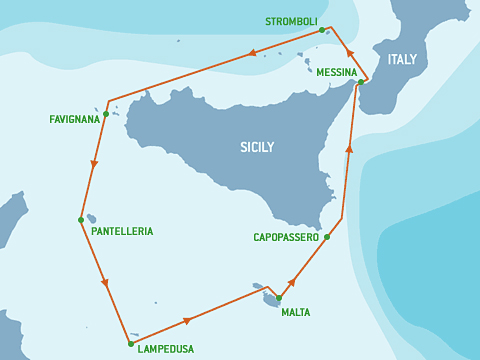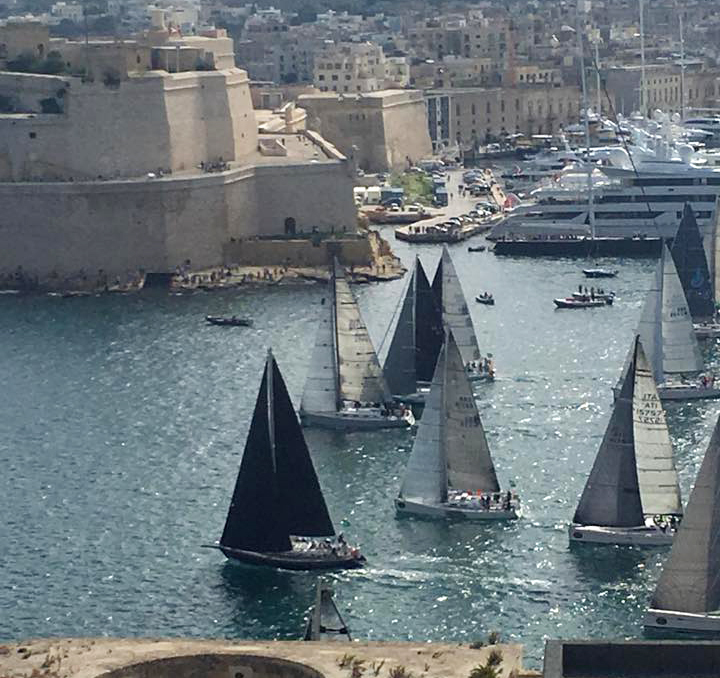Photo of TRIPLE LINDY finishing the 2017 Rolex Middle Sea Race courtesy of Rolex/Kurt Arrigo.
In October, Joe Mele’s Swan 44 MkII TRIPLE LINDY won IRC Class 5 of the storm-racked 2017 Rolex Middle Sea Race. The race is one of the top ocean races in the world and shares the ranks of the Newport Bermuda Race, Sydney Hobart Race and the Fastnet Race — and TRIPLE LINDY sailed them all in the last 18 months.
The 602-mile Middle Sea Race goes from Malta, counter-clockwise around Sicily and the islands in the middle of the Mediterranean Sea, and then back to Malta (see map). Mele’s team won the start and kept the lead on corrected time for practically the whole race. After nearly four full days of racing, TRIPLE LINDY was second across the line in IRC Class 5, and corrected to first in class by a nearly an hour. “Most of the race was sailed in gale or near gale conditions,” said Mele. “But those are the perfect conditions for our Swan 44.”
Libby O’Brien’s photo showing TRIPLE LINDY (black sails and fixed sprit) winning the start of IRC Class 5 of the 2017 Rolex Middle Sea Race.
“We got a lot of good advice from UK Sailmaker’s Butch Ulmer when putting together our sail inventory for these classic ocean races. Importantly, he told me to invest in a real racing No. 4 to replace my Dacron No. 4 so that we would be able to sail upwind with a well-shaped sail. In this race, we ended up using our UK Tape-Drive® No. 4 for two of the four days.
“Butch also convinced me not to get rid of my spinnaker pole after we converted the boat to an asymmetrical spinnaker flown off a five-foot fixed-sprit. He said that the pole could be used to wing-out a small jib when running in winds too strong for a spinnaker. On the 90-mile DDW-run from Pantelleria to Lampedusa, the winds blew 18-45 knots from dead astern. Sailing wing-on-wing with the No. 4 poled-out, we surfed over 12 knots under complete control as passed others who wiped-out with their asymmetrical spinnakers.”
Instruments on the mast read from top down:
Heading: 152°
Boatspeed: 12.4 knots
Apparent Wind Angle: 169°
True Wind Direction: 324°
True Wind Speed: 31.6 knots
“Butch also convinced me to move the traveler from the cabin top to the cockpit where the trimmer would have an easier time adjusting it, another key change for the better.
“We reefed and un-reefed constantly during the race. To make reefing easier, we added a second main halyard clutch. That way, before the reefing process started, we could open the aft clutch and pull the halyard through to the mark we made to make the reef. Then the aft clutch was closed. When everyone was ready for action, the forward clutch was opened and the sail came down just enough for the reef. Not only was this system fast, it also allowed us to take our time and get ready for a safe maneuver, even in the dark. Pete Ramsdell, one of my long-time crewmembers suggested this idea.
“The hairiest moment of the race was when we got hit by a vertical wave that was 30-40 feet high. Everyone on deck at the time was airborne and then fell to the deck in a tangle. One guy banged his head and bruised both his shoulders. I went from skipper mode to doctor mode. It took two days of bed rest for him to recover.”
Another lesson Mele’s crew learned was that heavy air genoas, like No. 3s and No. 4s that have battens, should not be leech stacked. Most racing sailors leech stack jibs with battens so that the turtled sail can be folded in thirds and stored easily below. The Triple Lindy crew learned that trying to get the sail into the headstay foil when then the luff is not stacked is too hard in a blow. While the turtled sail can’t be folded, being able to get the sails up and down is more important than saving space below.
Mele borrowed an old advertising line for a watch company when describing his UK Sailmakers inventory, “They took a licking and kept on ticking.”
Mele plans to sail the next Hobart race in his new boat, which is a Cookson 50. We wish him and his team continued good luck.



Dear Triple Lindy Owners,
is the boat still on the market and would it be possible to inspect it on Oct. 4th 2019 ?
best regards
Peter
Dear Triple Lindy Owners,
is the boat still on the market and would it be possible to inspect it on Oct. 4th 2019 ?
best regards
Peter